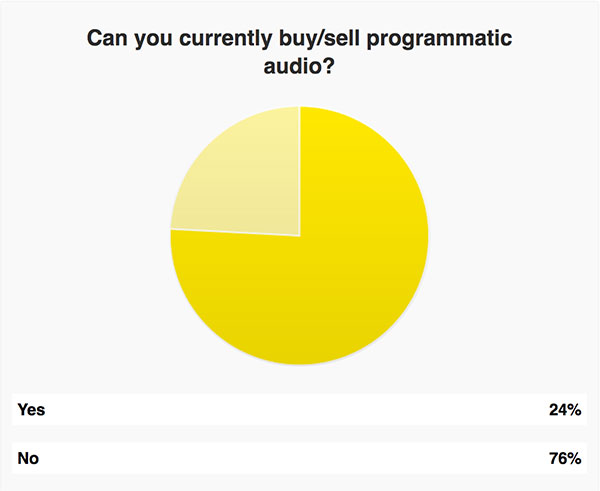Save 50% on a 3-month Digiday+ membership. Ends Dec 5.
Digiday Research: 24 percent of marketers can now buy or sell programmatic audio
This research is based on unique data collected from our proprietary audience of publisher, agency, brand and tech insiders. It’s available to Digiday+ members. More from the series →
Digiday’s “Research in brief” is our newest research installment designed to give you quick, easy and digestible facts to make better decisions and win arguments around the office. They are based on Digiday’s proprietary surveys of industry leaders, executives and doers. See our earlier research on the publisher pivot to video here.
A comprehensive report on 2016 U.S. advertising spend by the Interactive Advertising Bureau and PwC earlier this year found that digital audio produced $1.1 billion in ad revenue — the first time digital audio generated enough revenue to warrant its own reporting line. This accounted for roughly 2 percent of the $72.5 billion spent on digital advertising. Although seemingly small in comparison to display or video ads, digital audio ads have seen strong growth in recent years.
Fueled by programmatic, this growth should continue, according to Digiday’s recent poll of advertising executives at the Digiday Programmatic Summit Europe. Twenty-four percent of people claimed they could buy or sell programmatic audio.

Programmatic audio is becoming a bigger part of the audio and digital advertising market. Both SoundCloud and Spotify have expanded their programmatic audio offerings. Podcasting has steadily grown in popularity, bringing with it new advertising opportunities. A record 67 million Americans listen to podcasts every month, according to a 2017 study by Edison Research in collaboration with Triton Digital. Digiday’s Jessica Davies recently noted that legacy media players, including News UK, Bauer and Global Radio, have also ventured into programmatic audio.
Marketers like digital audio because of its high completion rates and low risk of ad fraud and brand-safety issues. Proponents of programmatic audio have further cause for optimism after a recent eMarketer study found that U.S. adults spend more time on mobile devices listening to digital audio than doing anything else. Devices like Amazon’s Alexa and Google Home will boost both streaming time and advertising, but there have been hiccups.
More in Media

Marketers move to bring transparency to creator and influencer fees
What was once a direct handoff now threads through a growing constellation of agencies, platforms, networks, ad tech vendors and assorted brokers, each taking something before the creator gets paid.

Inside The Atlantic’s AI bot blocking strategy
The Atlantic’s CEO explains how it evaluates AI crawlers to block those that bring no traffic or subscribers, and to provide deal leverage.

Media Briefing: Tough market, but Q4 lifts publishers’ hopes for 2026
Publishers report stronger-than-expected Q4 ad spending, with many seeing year-over-year gains.





